Toddy Palm (Asian Palmyra Palm) Uses, Research, Medicines, Side Effects
Tala (Toddy palm) – Borassus flabellifer is an Ayurvedic herb used for the treatment of difficulty in micturition, general debility, diarrhea, psychiatric conditions, hepatomegaly and acidity.
Latin name- Borassus flabellifer Linn.
Family- Arecaceae/ Palmae
Borassus = juice which flows from wounded spathe of this palm.
Flabellifera= yielding fan leaves.
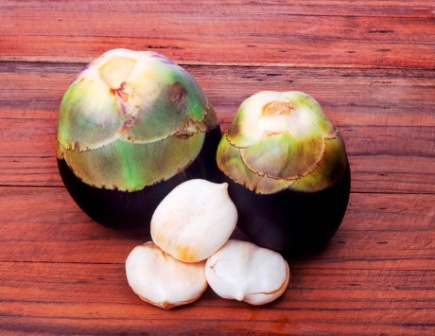
Table of Contents
Vernacular names
Names in different languages:
Hindi name: Taltar, Thada, Tala, Tar
English name: Palmyra palm, Palm tree, Toddy palm
Arabic name: Thara
Bengali name: Thala
Gujarati name: Thada
Kannada name: Kharathala, Talimara, Tale Mara, Tati hannu,
Malayalam name: Karimpana, Pana
Marathi name: Thada
Tamil name: Panaimaram, Nonkuppanai
Telugu name: Tharichettu, Thalhi
Sanskrit synonyms
Sanskrit Synonyms of Tala:
Talah: Because of its shukrala property provides strength to the body.
Taru Raja, Drumeshwara, Trina Raja: This tree is considered as the king for those plants which will have leaves at the tip like Graminae & Palmacae member.
Lekha Patra, Lekhya patra: Its leaf is useful for writing purpose in the ancient days.
Deerga Skandha, Deerga Vruksha, Deerga Danda, Dirghaskandhah : It is having a long branches.
Deergha Patra – long leaves
Guccha Patra – leaves appear in bunches
Mahaphala: The fruit is big in size.
Mahavriksha: The whole tree is long & big in size.
Madakrud Druma – causes intoxication (wine)
Madhu Rasa – sweet in taste
Chirayu: The life span increases if taken internally.
Shree Beeja – auspicious
Chirayu – lives long
Maha phala: The fruits are big
Gaja Bhakshya – eaten by elephants
Mahabala – improves strength, strong tree
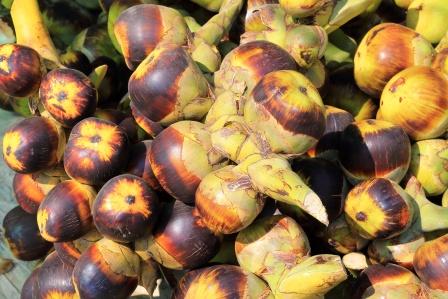
Dhwaja Vruksha, Dhwaja, Dhwajadrumaha,
Duraruhah, Tenarajah, Lekhya patrah, Dirghataruh, Chala
Shala Shava, Drudha Chada
Morphology
Morphology of Borassus Flabellifer:
Borassus flabellifera is a robust tree and can reach a height of 30 m. The trunk is grey, robust and ringed with leaf scars; old leaves remain attached to the trunk for several years before falling cleanly. The leaves are fan-shaped and about 3 m long, with robust black teeth on the petiole margins. Like all Borassus species, B. flabellifer is dioecious with male and female flowers on separate plants. The male flowers are less than 1 cm long and form semi-circular clusters. In contrast, the female flowers are golf ball-sized and solitary, sitting upon the surface of the inflorescence axis. After pollination, these blooms develop into fleshy fruits 15–25 cm wide, each containing 1-3 seeds. The fruits are black to brown with sweet, fibrous pulp and each seed is enclosed within a woody endocarp. The fruit measures 10 cm to 18 cm in diameter, has a black husk, and is borne in clusters. The top portion of the fruit must be cut off to reveal the sweet jelly seed sockets, translucent pale-white. The sweet jelly seed sockets occur in combinations of two, three or four seeds inside the fruit. The jelly part of the fruit is covered with a thin, yellowish-brown skin. These are known to contain watery fluid inside the fleshy white body.
Properties, part used, dosage
Sugar Palm medicinal properties:
Rasa (Taste) – Madhura (Sweet)
Guna (Qualities) – Guru (Heavy for digestion), Snigdha (Slimy in nature)
Vipaka – Madhura (Undergoes sweet taste after digestion)
Veerya (Potency) – Sheeta (Cold)
Karma (Actions) – Vatapitta shamaka (reduces vitiated vata and pitta dosha)
Part used- Fruit, Flower, Juice, Root
Dosage-
Root powder- 10 to 20 g
Juice- 50 to 75 ml
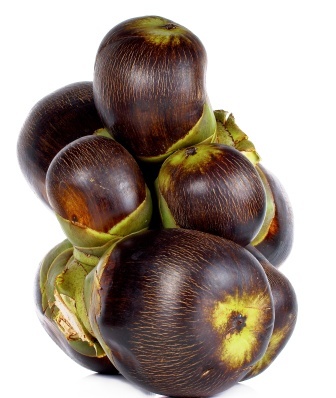
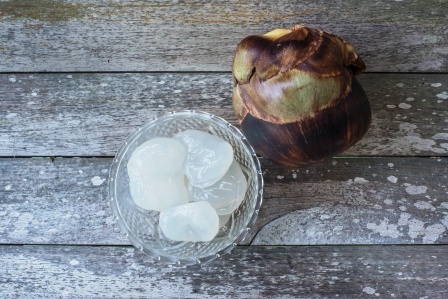
Chemical composition
Chemical composition of Borassus flabellifer:
The fresh sap of palms called sweet toddy or nira contains 12-12.6% of sucrose, 13.5% of carbohydrate, little amount of proteins, fat, mineral substances & vitamin c. The latex is a good source of vitamin B-complex. The pulp of ripen fruit contains good amount of vitamin C, protein, fat, mineral substances and carotene.
Uses
Uses of Tala:
In condition of hepatomegaly, the ash of the flower of Tala tree is taken in dose of 3-5 g with jaggery.
Sugar candy or sugar manufactured from the palm is used in conditions of cough and pulmonary infections.
Ash obtained by burnt inflorescence in a dose of 3-5 g is a given to treat hyperacidity, splenomegaly and hepatomegaly.
In conditions of difficulty in micturition, the juice of Borassus Flabellifer along with sugarcane juice is administered to relieve the condition.
To relieve thirst and fatigue, the fruit pulp of Tala is consumed. The pulp also is a good medicine to improve the sexual vigor and improve sperm count.
The juice of leaf stalk of Borassus Flabellifer is given in a dose of 15-20 ml to relieve hiccough and gastric reflux.
Gargling using the decoction of the tree bark of Palm along with pinch of salt is used to treat gingivitis and oral ulcer.
The root of Tala is pounded and a paste is prepared adding rice water. This paste is consumed in a dose of 5-6 g to treat diarrhea. The paste is also rubbed over the navel region to treat diarrhea.
Jaggery prepared from Tala juice is used as a good tonic/medicine to strengthen the uterine muscles in post- partum women.
In Visucika: Root of Tala is pounded with rice water and pasted on the navel. In checks visucika ( Vaidyamanorama).
In Insanity: Juice of the palm tree should be taken in such case (Vrundha).
In Muthra vikaras: In Muthra vyvarnya muthra kruchra ghee and milk cooked with tala fruit is useful is discolouration of urine and dysuria ( charaka)
In Mutragata: Tender root of tala pounded with cold rice water, juice of trapusa and white trapusa should be taken with milk in morning. (Shu.)
In dysuria caused by vitiated blood one should take decoction of utpalanala, tala, kasa, Iksubala, Iksu& kaseruka ( Cha.)
In Pleehodara: Ash of tala flower mixed with jaggery alleviates the disorder. (Chakradutta)
For sukhprasuti: The root collected from north direction should be made in a suthra form and it is tied in her hip region. ( Bhangasena)
The juice of leaf stalks and young roots is good for gastric catarrh and hiccough.
The ash obtained by burning the inflorescence is a good antacid & anti periodic and is useful in hyperacidity, heart burn, bilious fever, splenomegaly, haepatomegaly and skin diseases.
The sugar-candy produced in the manufacture of sugar from the palm is used in cough and pulmonary infections.
In Prameha, slightly fermented juice called toddy is given internally. With aromatics it is a good tonic in emaciations.
Sanskrit verse
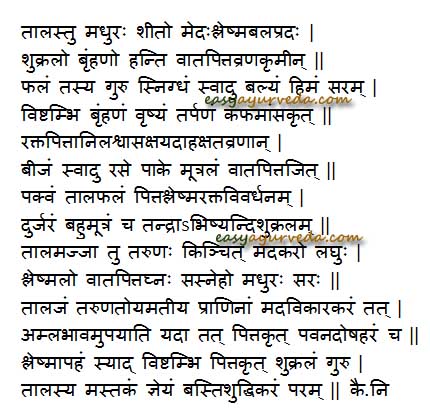
The milky fluid from the immature seeds is sweet & cooling & prevents hiccup & sickness
The toddy poultice prepared by adding fresh drawn toddy to rice flour and subjected to a gentle fire till fermentation takes place, then spread on a cloth forms a valuable stimulant application to gangrenous and indolent ulcers, carbuncles.
The decoction of bark with a little salt added to it is a good astringent gargle for strengthening gum and teeth.
Qualities, benefits, Indications
Traditional Ayurvedic qualities and benefits of Tala:
Madhura – sweet
Sheeta – coolant
Medakrut – increases fat
Kaphaprada – increases Kapha Dosha
Balaprada – improves strength and immunity
Shukrala – improves sperm and semen quantity and quality
Brimhana – improves weight
Vatapittahara – Balances Vata and Pitta Dosha
Indicated in
Vrana – Ulcers, wounds
Krumi – worm infestation
Tala fruit:
Guru – heavy to digest
Snigdha – unctuous, oily
Svadu – sweet
Balya – improves strength and immunity
Hima – coolant
Sara – induces mobility
Vishtambhi – causes constipation
Brumhana – nourishing, nutritious
Vrushya – aphrodisiac, improves vigor
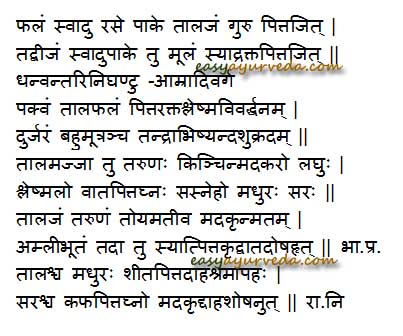
Indicated in
Raktapitta –Bleeding disorders such as nasal bleeding, heavy periods, etc
Shwasa – asthma and chronic respiratory disorders
Kshaya – depletion of body tissues, weight loss, tuberculosis
Daha – burning sensation, as in gastritis, neuropathy, burning sensation in eyes etc
Kshata – injury, bleeding
Vrana – Ulcers, wounds
Seeds:
Swadu – sweet taste
Mutrala – diuretic, improves urine flow
Vatapittahara – Balances Vata and Pitta Dosha
Ripe fruit:
May increase Pitta, Rakta and Kapha
Durjara – takes a long time to undergo digestion
Bahumutrakrut – increases urine volume
Causes Tandra – drowsiness, fatigue
Abhishyandi – sticks to the inner channels
Shukrala – improves sperm and semen quantity and quality
Tala Majja- Pulp part of the fruit:
Kinchit Madakara – slightly intoxicating
Laghu – light to digest
Shleshmala – increases Kapha Dosha
Vatapittaghna – Balances Vata and Pitta Dosha
Madhura – sweet
Sara – induces mobility, causes diarrhea, purgation, relieves constipation
Palm water:
Madakrut – causes intoxication
If it turns sour, it increase Pitta and Vata Dosha
Adverse effect
No adverse effect is known or reported after the normal use of Tala. However increased consumption of the fresh juice of the palm can cause features of intoxication.
Interaction with medicines, supplements
Can this be used while taking Homeopathic medicine?
Yes. This product does not react with homeopathic medicine.
Can
this medicine be continued while taking supplements like multivitamin tablets,
Omega 3 fatty acids etc?
Yes. Generally, this product goes well with most
of the dietary supplements. However, if you are taking more than one product
per day, please consult your doctor for an opinion.
With western
medicines
Seek your
doctor’s advice if you are taking this product along with other western
(allopathic / modern) medicines. Some Ayurvedic herbs can interact with modern
medicine.
If both Ayurvedic and allopathic medicines are advised together, then it is
best to take Allopathic medicine first, wait for 30 minutes and then take the
Ayurvedic medicine.
Ayurvedic medicines
Medicines containing Tala:
Redema tablet: It is a proprietary Ayurvedic medicine which relieves edema, pain and calculi & promotes weight loss.
Manikya Rasa: It is used in the treatment of skin diseases, gout, allergic skin conditions, dermatitis, fever, anemia, pruritis, hiccup, jaundice.
Asanadi kashayam: It is a medicine in decoction form, used in the treatment of diabetes, skin diseases and obesity etc.
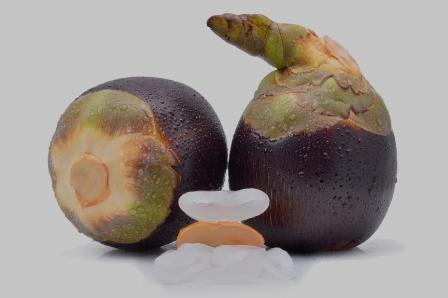
Panaviraladi bhasma: It is a Kshara type (alkali) of preparation used in the treatment of edema and ascites.
Research
Research related to Borassus Flabellifer:
Anti- bacterial activity: The present study was carried out to evaluate the antibacterial properties of different extracts of Borassus flabellifer belonging to the family Arecaceae, which has been using to treat different illnesses. The root part was selected for the antibacterial activity and different extracts were prepared using soxhlet extraction procedure using different solvents successively and those were tested for their antibacterial property using agar well diffusion method at different concentration on standard human pathogenic bacterial strains. The chloroform extract showed less activity compared to ethyl acetate and methanol extracts at low concentrations, but as the concentration increases the bactericidal activity was increased. The extracts showed more activity at 40mg/100μL. Among all extracts methanol extract showed more, but compared to ciprofloxacin the results on tested bacterial strains are not excellent. The extracts also showed more activity on gram negative bacterial strains. The extracts showed more activity on S. typhimurium and S. pneumonia and lower activity on S. aureus and E. coli.
Anti- oxidant activity: The present study was aimed to evaluate the antioxidant activity traditional medicinal plant, Borassus flabellifer. The root/rhizome part of plant was used for preparation of extracts using maceration process using different solvents. The extracts of plants were studied for free radical scavenging activity on 2, 2-diphenyl-1-picrylhydrazyl (DPPH), hydroxyl and superoxide free radicals and antioxidant capacity was studied using ferric thiocyanate (FTC) method. The selected plant extracts showed the concentration dependent percentage inhibition on tested free radicals. The extracts showed the good scavenging activity on DPPH free radical and less on hydroxyl free radical.
Anti- diabetic action: In the present study ethanolic extract of Borassus flabellifer flowers was screened for its anti-diabetic potential against alloxan induced diabetic rats. Oral glucose tolerance test (OGTT), blood glucose level, serum lipid profile and histological study of pancreas were performed. The free radical scavenging effect was studied by using DPPH method. After administration of the ethanolic extract, there was a significant reduction in fasting blood glucose levels from 60 min (OGTT) acute study reveals blood glucose lowering potential of 20 % at 6 hr whereas sub-acute study after 15 days of treatment it was observed to be 35 %. The extract exerts a significant DPPH radical scavenging effect.

Anti- inflammatory action: 90 grams of shade dried leaves powder of B. flabellifer is weighed and packed with a muslin cloth. Packed dried powder is kept for soxhlation for 6 hours using chloroform, and then powder is removed and kept for drying. Single dose of 0.02 ml of freshly prepared 2% formalin was used to induce chronic inflammation in mice. The results of anti- inflammatory activity of leaves extract of B. flabellifer showed positive result.
Classical categorization
Classical categorization of Date Palm:
Charaka Samhita- Madhura skanda, Kashaya skanda
Sushruta Samhita – Salasaradi gana, Shirovirechana, Madhur skanda
Vaghbhata – Asanadi gana
Dhanvantari Nighantu- Amradi varga
Bhavaprakasha- Amradi phala varga
Kaiyyadeva Nighantu- Oushadhi varga
Raja Nighantu- Prabadradi varga
Scientific classification
Kingdom: Plantae
Order: Arecales
Family: Arecaceae
Genus: Borassus
Species: B. flabellifer
Borassus = juice which flows from wounded spathe of this palm.
Flabellifer= yielding fan leaves.
Literary references
The drug Tala is not mentioned in vedic era. Charak mentioned Tala in madhuraskanda ( vi. 8. 136) and phala varga ( su. 27. 130). He mentioned its therapeutic uses like used in mutravaivarnya, mutrakruchra, mutragata etc.,
Sushruta has also mentioned in the Madhura Varga ( su. 42.18) and Phalavarga ( su. 46. 177. 310) and he also stated that it is useful in mutragata.
Chakradhata mentioned it is used in plihodara.
Vaidyamanorama mentioned it is used in visuchika.
Vridha mentioned it is used in unmade.
Bangasena mentioned it is used in sukaprasuthi.
Tala is one of the plant mentioned in nighantus
There are many references of Tala is Nighantus like kaiyadeva nighantu, raja nighantu, danvantari nighantu, nighantu adarsha, bhavaprakash nighantu and so on. In above mentioned nighantu’s, Tala is mentioned in different synonyms like trinaraja, dwajadhruma, dhirga skandha etc.,
Tala is also found in Paniniya’s Astadhyayi ( 4.3.152).
Vishnu purana ( su. 8.5) mentions the particular fragrance emitted from the Tala phala.
Varieties
Types/ Varieties
In Danvantari and Raja nighantu there is mentioning of 4 types of Tada/ Tala
Tala
Shritala
hintala
mada
Author: Dr.B.K.Prashanth M.D (Ayu), Ph.D
E mail: [email protected]
Click to consult Dr Prashanth BK










